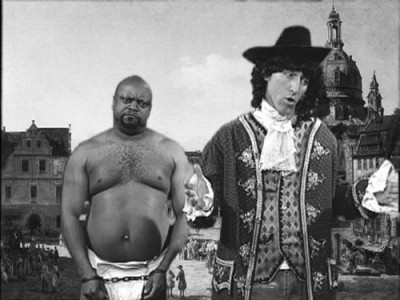
What better way to forge connections between two American minorities than through two men dressed up like grandmas squabbling about Jewish comfort and soul food?
“The Black-Jew Dialogues,” a touring play featuring Larry Tish and Lou Wilson, brought together various theatric performance techniques on Monday in the College of Arts and Sciences, furthering the never-ending conversation about race and diversity in America.
The event was organized through the combined efforts of the BU Hillel and Umoja BU student groups. Danielle Liberman, treasurer of Hillel, said the two groups hope to create a more unified front when it comes to combating racism and anti-Semitism in the United States, generating a dialogue between both the large Jewish and African-American communities on campus.
“The motive was to create laughter and understanding using people to raise awareness, using comedy to lower the temperature of the room when facing difficult ideas and different ideas in the world,” Tish said. “Satire has always been a way to make it easier to talk about.”
The play explores the absurdity of prejudice and racism and the power of diversity through modern performance techniques, combining fast-paced sketches, improvisations, multimedia, puppets, a game show and post-show discussion. This mixture of media, theater and dialogue creates a show that has gained praise from universities, high schools, synagogues and theaters across the United States, Canada and the United Kingdom.
Now revised to feature younger actors, Tish and co-creator Ron Jones have shifted the play’s aim toward not only a cross-cultural audience, but cross-generational one as well. The characters themselves, a traditional student and adult student working on a class project about cross-cultural dialogue, represent a sample of the types of diversity present today. The resulting discussion challenges both baby-boomers and millennials to critically examine the world around them in order to understand the true nature of diversity and how it has evolved in the 21st century.
In a sketch involving an affable black man and an uptight Jewish man, the interaction between two groups is represented while holding a balance between keeping the undercurrent of lightness and humor but also carrying the weight of meaning and enlightenment.
“For me, it is an epic representation for what the show stands for, the importance and earnestness of dialogue with the funny,” Wilson said.
The humor is key, Liberman said, but there’s much more weight on the earnest dialogue.
“The performance gives insight into the true nature of prejudice and how our inability to face our own biases separates us in ways that we may not even consider,” Liberman said. “Furthermore, the two performers also model a healthy dialogue, especially during moments of contention and disagreement.”
In engaging the audience, Wilson said, the play manages to draw its audiences into the discussion. Rather than letting the themes play out on stage, the performance becomes more of a conversation that depends on the audience to think.
“I think one of the most amazing parts of the play is the fourth wall is there when it needs to be, but can easily be opened up and help bring the audience in and make the conversation much easier,” Wilson said. “In order to have dialogue, it’s not just you watching us, it’s us watching you watching us and the interaction comes from that.”
Granted, that sort of conversation is easier said than done, but in Tish’s eyes, seeing the reward is worth taking the risk.
“Part of this show is to raise eyebrows and get people thinking, so we cross the line here and there, but that’s kind of the point,” Tish said. “If you’re doing social awareness theater and you’re not having to fight any fights, you’re probably not doing a good job. Controversy is the nature of the work.”














